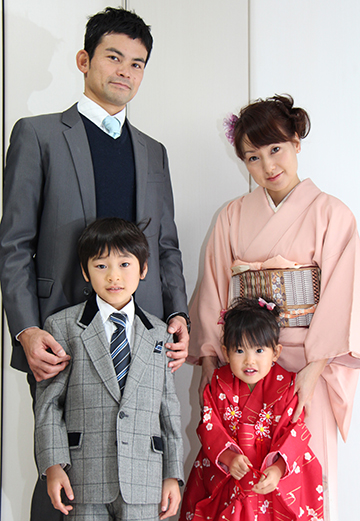Visiting plastic surgeon from Japan reflects on his UK experience
Editor’s note: Because his English is weak, Dr. Kaoru Sasaki opted to write his responses to interview questions for this article.
At the end of February, the Plastic Surgery division at the University of Kentucky (UK) bid a fond farewell to visiting professor Dr. Kaoru Sasaki and his family. Sasaki, a specialist in hand and craniofacial surgery, and his wife, Dr. Tsukasa Sasaki, a clinical radiologist, spent five months at UK as visiting professors from the University of Tsukuba in Japan. It was Kaoru Sasaki’s first extended visit to another country.
Since arriving last October, Kaoru Sasaki spent his time at UK trading information with colleagues about surgical techniques and procedures, teaching Plastic Surgery residents added skills in microsurgery, and presenting lectures at several national conferences.
Commenting on their decision to be visiting professors, Sasaki wrote that it was something he and his wife had always planned to do. The University of Tsukube offers a visiting professor support program to its faculty to encourage international study and collaboration.
Although the surgical and resident teaching responsibilities at Tsukuba challenges its faculty to move forward in their field, and to also move their field forward, Sasaki wrote that the static nature of Japanese culture can sometimes be a hindrance to a physician’s clinical development.
“We wanted to experience American multi-culturalism” in an academic medical setting and in daily life, Kaoru wrote. They also wanted to attend another teaching hospital in order to immerse themselves in a residency program typical of the United States. He was eager to experience a contrast to Tsukuba’s approach.
Kaoru’s “boss” suggested the University of Kentucky. His chief had spent his visiting professorship at UK and maintained a good relationship with Dr. Henry Vasconez, chair of the UK Plastic Surgery. Introductions were arranged and subsequent plans were made for them both to visit.
BRIDGING CULTURES IN THE OR
Sasaki’s primary goal for this visiting professorship was to improve his surgical skills in his specific specialties: hand surgery and craniofacial surgery. In particular, he was looking forward to observing and assisting in procedures that are relatively uncommon in his practice at home.
Over the course of his professorship, Kaoru participated in nasal reconstructions, which was an area of focus for his visit. He was especially pleased to work with Dr. James Liau on treating craniosynostosis in infants. His visit also included a two week rotation at the Christine M. Kleinert Institute for Hand and Microsurgery at the University of Louisville.
“Dr. [Harold] Kleinert is a famous hand surgeon noted for performing the first hand transplant. As a hand surgeon, I did not want to miss an opportunity to spend valuable time there,” wrote Dr. Sasaki.
Another area of keen interest for Dr. Sasaki was in the use of allografts. Generally, Japanese surgeons don’t get a chance to work with allografts because, culturally, the country has a negative view of organ donation and the use of donor tissue, particularly preserved tissue. Public opinion regarding organ donation has improved in the last 20 years, however Sasaki wrote that allograft procedures are still not covered by the country’s national health insurance. It is largely private pay and it is very expensive.
“University of Tsukuba hospital is a medical service provider under the national health insurance, so I don’t get to work with allografts,” he said. Working in the United States has given him an opportunity to learn how to use them, he said.
EDUCATION
Remarking on his experience at UK versus the University of Tsukuba, Sasaki liked the convenience of having the residency and fellowship program in one location. Japanese residents, he said, rotate among several large and small hospitals. This approach may give surgical residents in his home country more hands-on OR experience with a wide range of patients, but it is not as academically focused.
“In the small hospitals, a resident’s role is more of a worker than a learner,” Sasaki wrote. “So, they may develop surgical technique earlier than US residents.”
The approach at UK, in contrast, places an emphasis on critical thinking and problem solving, which, he believes, could lead to a more consistent surgeon when they reach the end of their program. Both approaches have their merits, he said.
In his own experience, in addition to participating in procedures new to him, Sasaki enjoyed the weekly and monthly conferences among faculty and residents covering a variety of topics. As a specialist, he greatly admired the microsurgery training courses at UK and U of L.
FAMILY LIFE
In terms of Dr. Sasaki’s primary goal for this visiting professorship, five months was just about right. He would, however, have liked more time to learn English.
His children, a 10-year-old son and six-year-old daughter, were almost better prepared than their parents, he said. His son and daughter had been taught some English at their primary schools back home. His wife had experience with English, too. He, however, didn’t have much, which made his first two months at Kentucky quite a challenge.
Fortunately for the family, there were plenty of Japanese speakers in Lexington to welcome them and to act as translators. At Picadome Elementary School, his children met other Japanese children their age that helped them and, most importantly, teachers fluent in Japanese to give them lessons so that they did not fall behind in their education.
“It did not take long for them to make friends while they were here,” he said. In fact, his family felt very welcome throughout their visit. He was especially glad for a chance to catch a UK game during their stay.
After half a year, he has noticed an improvement in his English which he hopes not to lose upon returning home. Being a visiting professor is something he would like to do again, though he is not sure when that will be. But a return to Kentucky is definitely in his family’s future.
